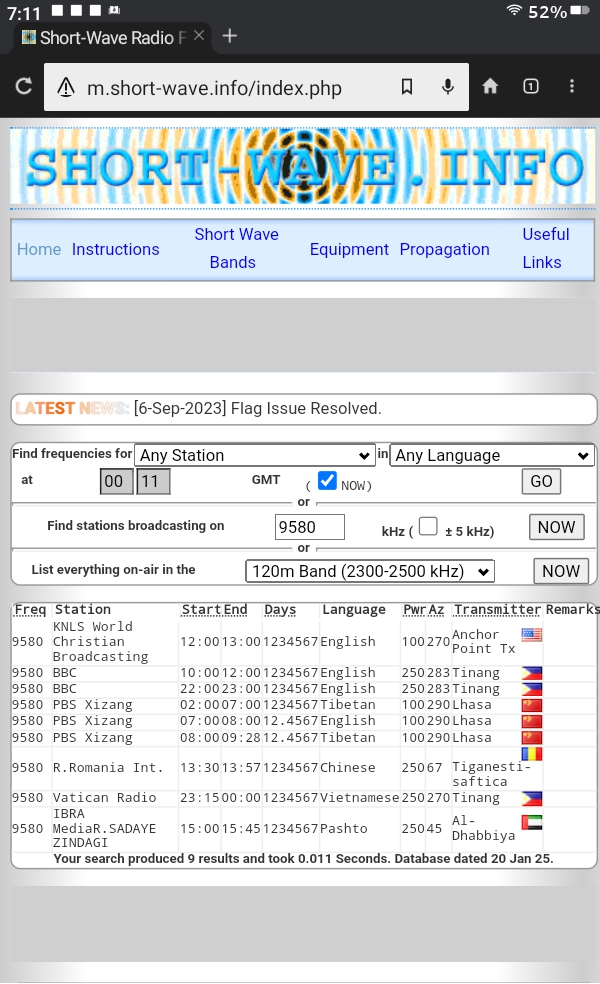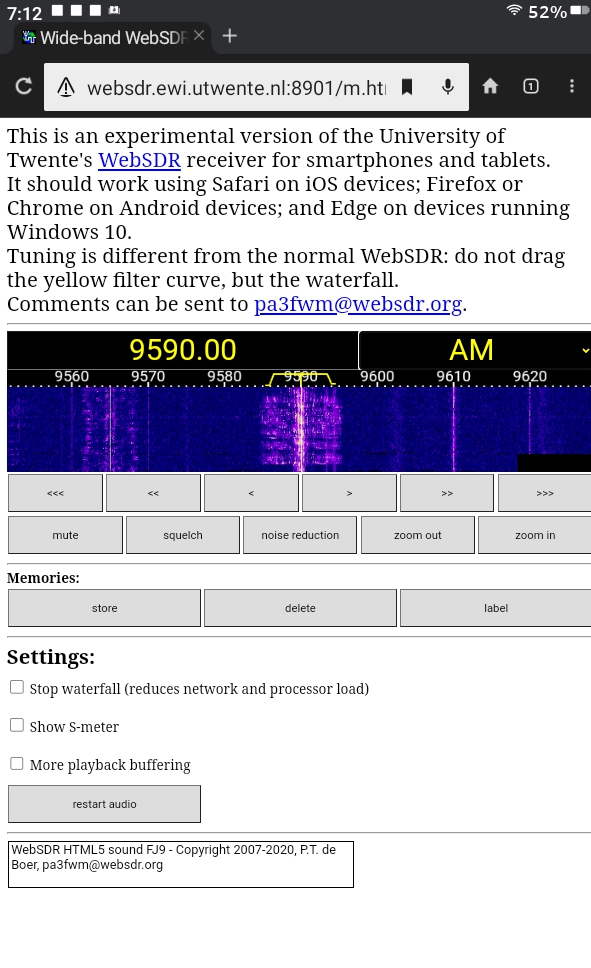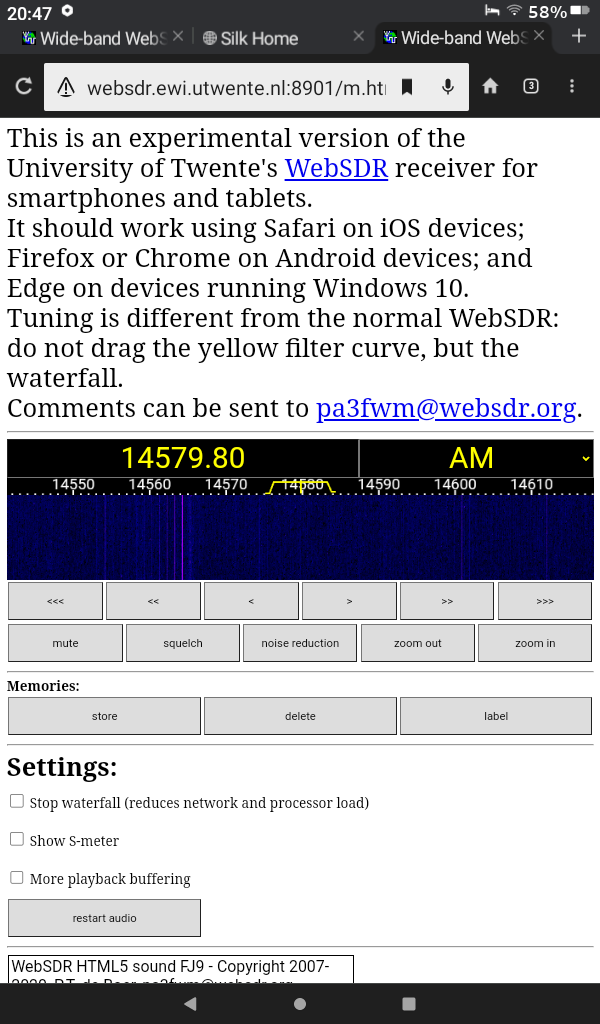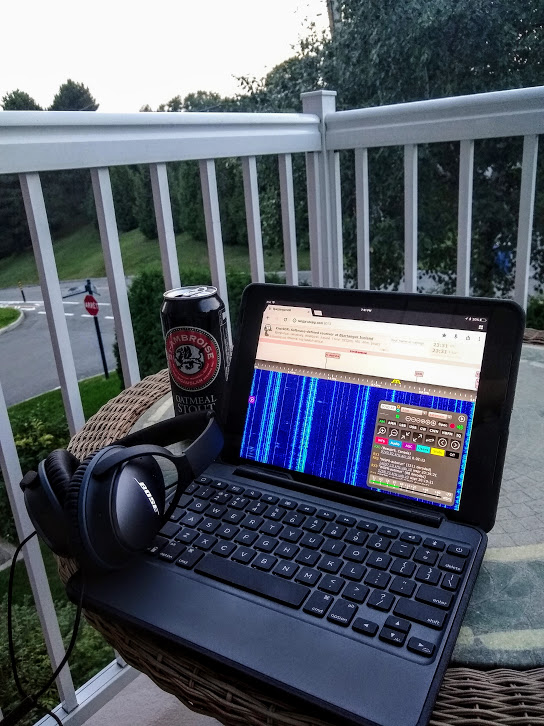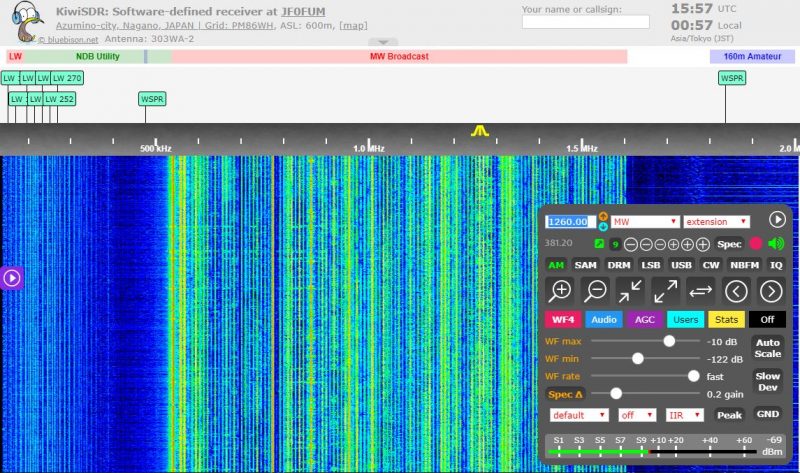 Many thanks to SWLing Post contributor Fred Waterer who shares this article from Radio World that takes a closer look at how online SDR networks have transformed shortwave listening. Even for those of us who regularly use Web SDRs, it’s an interesting perspective on how these global receiver networks continue to evolve and expand the reach of radio in the 21st century.
Many thanks to SWLing Post contributor Fred Waterer who shares this article from Radio World that takes a closer look at how online SDR networks have transformed shortwave listening. Even for those of us who regularly use Web SDRs, it’s an interesting perspective on how these global receiver networks continue to evolve and expand the reach of radio in the 21st century.
Tag Archives: WebSDR
Bob’s Radio Corner: Pairing a Phone or Tablet with a Radio
 Pairing a Phone or Tablet with a Radio
Pairing a Phone or Tablet with a Radio
By Bob Colegrove
The Internet is full of resources for radio listeners and hobbyists. There are numerous examples of general information, frequency, and schedule lists. There are also WebSDR sites, which allow you to compare reception experiences from around the world. All of these can be accessed quickly and easily by having them loaded on your phone or tablet operating side-by-side with your radio and having Wi-Fi or cellular access. We never had any of this when I was starting out.
I realize there are other ways to go about what I have described below, for example, merging station listings with SDR. This posting is for folks like me who are SDR-challenged. I listen to plain old radios. My modern-day experience with newfangled technology has been limited to hitchhiking on WebSDR sites for the last few years. It has served me well.
Ideally, I would like to generalize this topic to simply cover all phones and tablets. In truth, my experience has been limited to an iPhone and Kindle Fire tablets. They have worked very well as I shall explain. Perhaps you have paired a different phone or tablet with your radio, in which case, feel free to share your experience.
The choice of a phone or tablet is yours. Either works well. Your decision will be affected by what you have available and what is easier to use. If you intend to buy a new device and associate it with your radio, cost will be an additional factor.
A noteworthy device (the one I tend to favor) is a Kindle Fire. Mainly, they are cheap. The regular price of a 7-inch model is just under $60 and can often be purchased for less during Black Friday and Prime Day sales. It is versatile, possessing all the usual functions except for cellular access. Perhaps most importantly, it is virtually noise-free. For a while I struggled using Internet sources on a laptop computer. Even a good one located about 10 feet away from the radio antenna generates noise. On the other hand, I have taken a 7-inch Kindle Fire in hand and placed it against the resonant coil of a loop antenna. This abuse generated no more disturbance to the antenna than if it were a block of pinewood. I have noticed some slight noise from the 11” Kindle when the antenna is exposed this way, but when that tablet is held at arm’s length from the antenna, all is well. Recently, I have expanded this application to my iPhone and found its noise immunity matches that of the Kindle Fire 7.
Broadcast Schedules
The most useful Internet resources are the broadcast schedules. These are the comprehensive frequency-time-station listings that tell us where and when to tune. There are many good ones. My favorites are the EiBi listing http://www.eibispace.de/, and Dan Ferguson’s https://groups.io/g/swskeds/topics. For the latter you will need to request membership. SWskeds merges EiBi, Aoki (https://www1.s2.starcat.ne.jp/ndxc), HFCC (https://new.hfcc.org/index.php), as well as other sources into a single list.
Processing
The EiBi listing comes as a CSV-formatted text file, which can be imported into a spreadsheet. I have done some processing using spreadsheet functions to produce a customized listing. Processing the frequency-time-station lists is most conveniently done using a computer rather than the phone or tablet. Processing includes selecting, arranging, or filtering the downloaded data tailored to your needs. This might include adding a filterable column to indicate only stations that are on at the current time. Some users might favor filtering by country or station. The heavy lifting processing is done automatically whenever a new listing is published by simply dropping the new file into the existing spreadsheet. No, the functionality of a spreadsheet and ease of editing are not as good on a tablet as with the mouse and keyboard of a computer. My processing on the computer includes measures to optimized the screen view to the most essential information thus minimizing the amount of scrolling on the tablet.
After the files are downloaded and processed, they can be loaded on the phone or tablet in a couple of different ways. They can be directly transferred over a USB cable, or they can be transferred using a cloud server. The USB cable-transfer method may be difficult on some devices, particularly iPhones. The Kindle seems to be the more convenient device. Being an obedient Microsoft customer, I can also transfer the files from my computer to OneDrive, then pick them up on the Kindle or iPhone using the OneDrive and Microsoft 365 apps which are available for both phone and tablet.
Examples
The screenshot below shows an EiBi example at 0014 UTC. Although the “ON” column filter is set to show only transmissions currently “ON,” it had not been manually updated on the Kindle for a couple hours and thus includes listings from a previous time. The EiBi database does not include transmitter power or beam information. However, the identification of countries and transmitter sites is extensive. These are determined by downloading and printing the README.TXT file on the EiBi site.
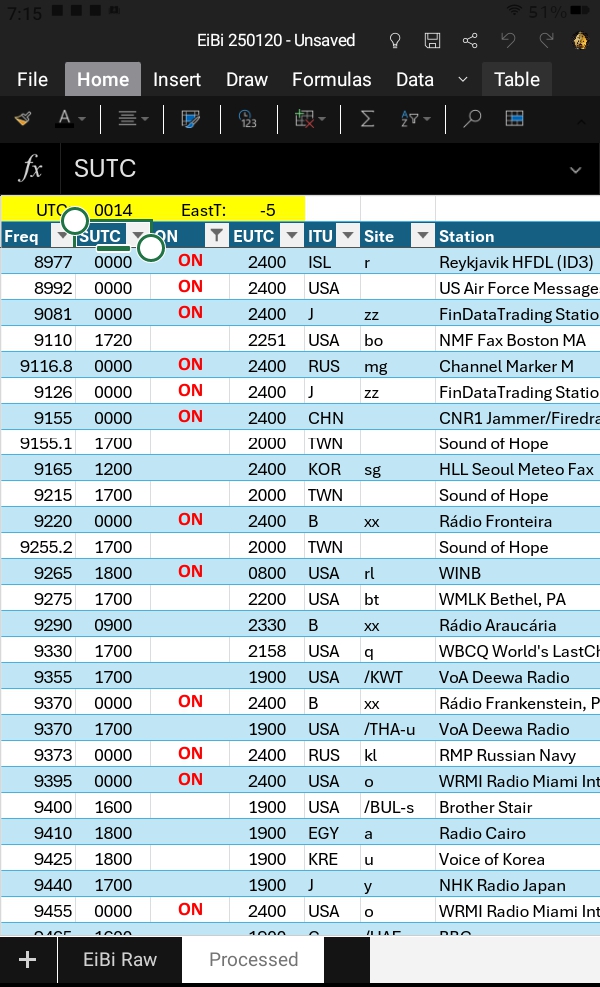 The SWSkeds listing is available in both CSV and Excel formats. It contains several additional data fields, very importantly including transmitter power and beam direction when available. For this list, I make the simple conversion of the existing Excel data range tab, “COMBINED” to a table so I can easily apply filters. The screenshot below shows an example at 1750 UTC with the “ON” column filtered to “ON.”
The SWSkeds listing is available in both CSV and Excel formats. It contains several additional data fields, very importantly including transmitter power and beam direction when available. For this list, I make the simple conversion of the existing Excel data range tab, “COMBINED” to a table so I can easily apply filters. The screenshot below shows an example at 1750 UTC with the “ON” column filtered to “ON.”
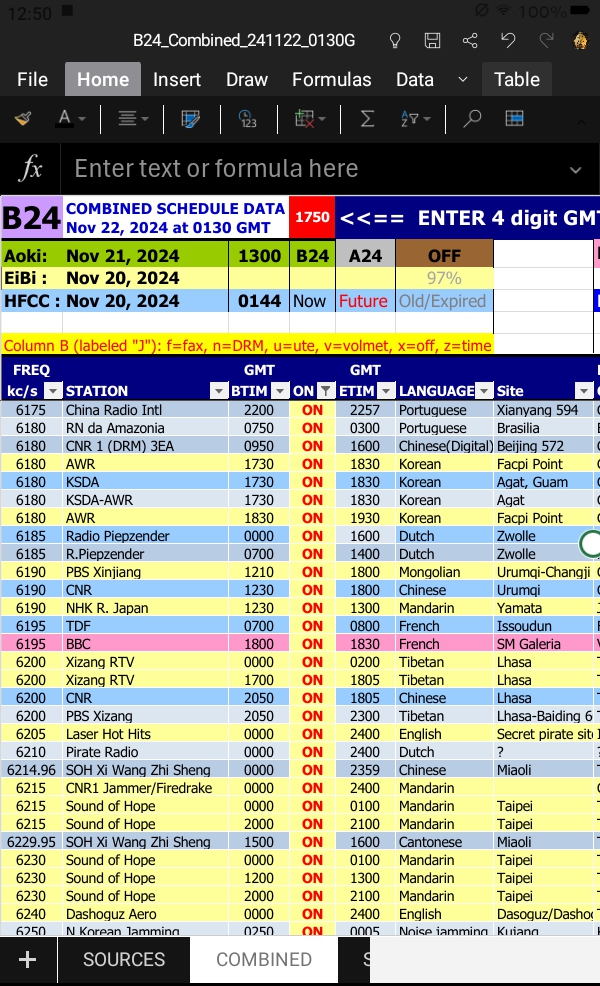 Not to be left out, the complete medium wave broadcast station list for Region 2, the Americas, is easily downloadable at https://www.fcc.gov/media/radio/am-query. The entire database is formidable and contains nearly 600 pages in a printable format. Much of this bulk is due to the doubled size necessitated by giving both daytime and nighttime power separate entries for each station. A number of marginally useful data columns can be eliminated in spreadsheet processing. I have added formulas to calculate the azimuth heading and distance from my listening post (blanked out in the example below).
Not to be left out, the complete medium wave broadcast station list for Region 2, the Americas, is easily downloadable at https://www.fcc.gov/media/radio/am-query. The entire database is formidable and contains nearly 600 pages in a printable format. Much of this bulk is due to the doubled size necessitated by giving both daytime and nighttime power separate entries for each station. A number of marginally useful data columns can be eliminated in spreadsheet processing. I have added formulas to calculate the azimuth heading and distance from my listening post (blanked out in the example below).
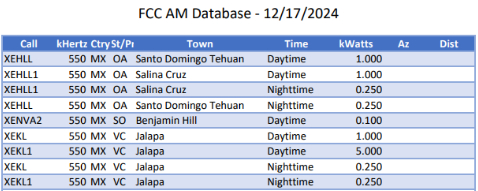 A variation of the downloadable file format is the direct-query site, SHORT.WAVE.INFO. Here you can simply enter queries by station, language, frequency, or band, and produce listings which match your criteria. Any listings which are currently on the air will be highlighted in red.
A variation of the downloadable file format is the direct-query site, SHORT.WAVE.INFO. Here you can simply enter queries by station, language, frequency, or band, and produce listings which match your criteria. Any listings which are currently on the air will be highlighted in red.
WebSDR
Finally, I would like to mention the WebSDR sites. While not used explicitly for broadcast schedules, these sites are great for anyone wanting to compare how well they are receiving signals relative to what others are experiencing. Granted, location and time of day are big factors that affect reception, but it is still useful to make these relative comparisons.
Home base is http://websdr.org/ which presents a catalog of many WebSDR sites by location. At the bottom of the page is a world map which pinpoints the location of each site. Most of these sites cater exclusively to hams; however, The University of Twente, Enschede, Netherlands (http://websdr.ewi.utwente.nl:8901/) covers 0.000 to 29.160 MHz unabridged. The screenshot below shows the tablet/phone version of the U. of Twente site. There are also two sites on the US East Coast which cover some non-hamband portions of the SW spectrum: http://na5b.com:8901/ in the Washington, DC area and http://websdr.k3fef.com:8901/ in Milford, Pennsylvania. The SHORT.WAVE.INFO and WebSDR sites can be directly accessed and queried over the tablet’s browser and a Wi-Fi or cellular connection.
Using the System
In my relentless pursuit to log the Nibi-Nibi Islands, I will load up one of the frequency-time-station listings and start my DX session. This typically includes a scan of a particular band, checking signals I can receive against the lists. If my interest peaks on a particular catch (usually a weak one), I will switch the tablet over to a WebSDR site to see how it is being received in Europe or along the East Coast of NA.
In summary, ready access to these Internet resources using a phone or tablet next to the radio has notable advantages:
- The frequency-time-station listings provide quick, reliable signal identification in most cases.
- The WebSDR sites confirm that my antennas are doing their job.
Am I done? I hesitate to stop here. The process of discovery is a marvelous human experience. The foregoing are merely starting points. Other applications might include sunrise-sunset calendars or maps or propagation forecasts. There are certainly other ways to do all this depending on your druthers. I know I am erring by omission and neglecting many other good resources. Let’s hear about yours.
U Twente WebSDR: New Tablet/Phone Interface Option
Many thanks to SWLing Post contributor, Bob Colegrove, who shares the following guest post:
U. of Twenty Site for Phones and Tablets
by Bob Colegrove
I’m not sure if this is new. It may have been around for a while. Very recently, while accessing the WebSDR site at the University of Twente, it detected that I was on a tablet and offered redirection to an experimental version of their site: http://websdr.ewi.utwente.nl:8901/m.html.
Besides being an interesting site to surf radio stations, I use it regularly as a ‘spotter’ tool to see what’s on shortwave. Admittedly, it is more than 3,900 miles from my receiver, but I like to see how well my antennas are doing.
The experimental version was accessed using the Silk browser on a 7-inch Kindle Fire. It is slimmed down from the main version, and much easier to use with a phone or tablet, particularly the zoom in and out feature.
Frank’s take on WebSDRs and the SWL Contest that encourages use of them
 Many thanks to SWLing Post contributor, Frank, who writes:
Many thanks to SWLing Post contributor, Frank, who writes:
Hi, I am Frank SWL F14368, organizer of the SWL Contest 2024. I have written an article [about the use of WebSDRs]. Maybe you like to share on your nice website for SWL ?
https://icomjapan.blogspot.com/2023/12/listen-world-for-free-on-your-computer.html
My contest is open to listeners who use a Kiwi or a WEB SDR. Not many contest accept this.
Thank you very much.
Best regards
73 de Frank SWL F-14368 / FØDUW
Radio Waves: Old Gen FM Radio, Radio Burst Model Challenged, Iceland WebSDR, and Ida Destroys WZRH/KVDU Tower
Radio Waves: Stories Making Waves in the World of Radio
Because I keep my ear to the waves, as well as receive many tips from others who do the same, I find myself privy to radio-related stories that might interest SWLing Post readers. To that end: Welcome to the SWLing Post’s Radio Waves, a collection of links to interesting stories making waves in the world of radio. Enjoy!
Many thanks to SWLing Post contributors Dennis Dura, Troy Riedel, Dan Van Hoy, and the Southgate ARC for the following tips:
FM Radio, the choice of an old generation (Hackaday)
Had the pandemic not upended many of this summer’s fun and games, many of my friends would have made a trip to the MCH hacker camp in the Netherlands earlier this month. I had an idea for a game for the event, a friend and I were going to secrete a set of those low-power FM transmitters as numbers stations around the camp for players to find and solve the numerical puzzles they would transmit. I even bought a few cheap FM transmitter modules from China for evaluation, and had some fun sending a chiptune Rick Astley across a housing estate in Northamptonshire.
To me as someone who grew up with FM radio and whose teen years played out to the sounds of BBC Radio 1 FM it made absolute sense to do a puzzle in this way, but it was my personal reminder of advancing years to find that some of my friends differed on the matter. Sure, they thought it was a great idea, but they gently reminded me that the kids don’t listen to any sort of conventional broadcast radio these days, instead they stream their music, so very few of them would have the means for listening to my numbers stations. Even for me it’s something I only use for BBC Radio 4 in the car, and to traverse the remainder of the FM dial is to hear a selection of easy listening, oldies, and classical music. It’s becoming an older person’s medium, and it’s inevitable that like AM before it, it will eventually wane.
There are two angles to this that might detain the casual hacker; first what it will mean from a broadcasting and radio spectrum perspective, and then how it is already influencing some of our projects. [Continue reading…]
New observations challenge popular radio burst model (Sky and Telescope)
Strange behavior caught by two radio observatories may send theorists back to the drawing board.
Fourteen years ago, the first fast radio burst (FRB) was discovered. By now, many hundreds of these energetic, millisecond-duration bursts from deep space have been detected (most of them by the CHIME radio observatory in British Columbia, Canada), but astronomers still struggle to explain their enigmatic properties. A new publication in this week’s Nature “adds a new piece to the puzzle,” says Victoria Kaspi (McGill University, Canada). “In this field of research, surprising twists are almost as common as new results.”
Most astronomers agree that FRBs are probably explosions on the surfaces of highly magnetized neutron stars (so-called magnetars). But it’s unclear why most FRBs appear to be one-off events, while others flare repeatedly. In some cases, these repeating bursts show signs of periodicity, and scientists had come up with an attractive model to explain this behavior, involving stellar winds in binary systems.
However, new observations by European radio telescopes may rule out this model.
Astronomers knew that FRB 20180916B, located in a galaxy some 475 million light-years away, produces multiple bursts about every 16 days, during a ‘window’ that lasts for a few days. “The idea was that the magnetar is part of a binary system with a 16.29-day period,” says Inés Pastor-Marazuela (University of Amsterdam), the first author of the new paper. If the companion star had a thick stellar wind that absorbs radio waves, the bursts would only be visible when the magnetar was on ‘our’ side of the orbit, she explains. [Continue reading…]
New WebSDR in Iceland (Southgate ARC)
Iceland’s IRA reports on August 24 Karl Georg Karlsson TF3CZ connected a new receiver over the internet covering 24-1800 MHz
A translation of the IRA post reads:
QTH is Perlan in Öskjuhlíð in Reykjavík. These are Airspy R2 SDR receivers for 24-1800 MHz (on VHF and UHF). The antenna is a Diamond D-190.
Karl Georg stated the following on FB:
The extension is not just for 2m, it can only be on one band at a time. So if one user switches, others who are connected also move between bands. (However, you can listen to each frequency within the same band). The receiver automatically tunes to APRS QRG 144.800 MHz, see the APRS website: http://SDR.ekkert.org/map
URL of the receiver
http://perlan.utvarp.com/#freq=24890000,mod=usb,sql=-150
Thanks to Karl Georg for his valuable contribution. This is an important addition for radio amateurs who experiment in these frequency ranges, as well as listeners and anyone interested in the spread of radio waves.
IRA Board
Source Iceland’s national amateur radio society, the IRA
https://tinyurl.com/IcelandIRA
WZRH/KVDU Tower Destroyed By Hurricane Ida (Radio Insight)
The nearly 2000 foot tower utilized by Cumulus Media Alternative “Alt 92.3” WZRH LaPlace and iHeartMedia Variety Hits “104.1 The Spot” KVDU Houma LA was toppled by the winds of Hurricane Ida.
The 1999 foot structure was constructed in 1988 to host both signals. Only the bottom 150 to 200 feet remain standing. Both stations are licensed to operate with 100kW/591m, but have low powered auxiliary sites in downtown New Orleans. WZRH is located on the roof of Place St. Charles with 630w/200m. KVDU is on the Hancock Whitney Center with 1.2kW/220m.
In addition to KVDU, iHeartMedia Gospel 940 WYLD is silent at its cluster. The company reports that the remainder of its signals are now operational after all but 93.3 KQUE and 98.5 WYLD-FM were off the air on Monday.
Cumulus Media states that its entire cluster of WZRH, Adult R&B 102.9 KMEZ Belle Chasse, Country “106.1 Nash-FM” WRKN Picayune MS, and Hot AC “106.7 The Krewe” KKND Port Sulphur LA are off the air. [Continue reading…]
Do you enjoy the SWLing Post?
Please consider supporting us via Patreon or our Coffee Fund!
Your support makes articles like this one possible. Thank you!
Should web-based SDR loggings be included and shared in regular logging columns?
Many thanks to SWLing Post contributor, Richard Cuff, who writes:
Radyo Pilipinas is one of those English language stations that are not very likely to make to my Pennsylvania location, even under excellent conditions, simply because propagation of their frequencies wouldn’t reach eastern North America when they’re on the air.
Web tunable SDRs change all that…I caught them today from 0315 to their 0330 signoff on 15640 and 17620, in English, with a chatty travelogue program.
I was listening via an Indonesian Kiwi SDR located in Jakarta.
I’m left wondering — is there interest in reporting logs like this? We wouldn’t normally include them in the regular Loggings column in the NASWA Journal, because I’m not tuning my radio, I’m in front of a computer screen tuning half a world away.
FWIW, Radyo PIlipinas broadcasts in English daily from 0200 to 0330 on 15640, 17700 (announced but not heard) and 17620 kHz.
73 – Richard Cuff / Allentown, PA (virtually in Jakarta, Indonesia…)
Wow–what a great question, Rich.
I suspect some DXers have very strong feelings about WebSDR loggings, both for and against.
In terms of loggings columns with various radio clubs and organizations, I suppose it’s up to the governing body to decide. As you say, I suspect it will come down to whether or not remote radio operation counts. With a KiwiSDR, for example, you’re controlling a remote receiver–one that is physically located in a known geographic spot–and the audio is being piped over the Internet. I know it wouldn’t be in the spirit of the thing if you submitted logs implying you’d logged Radyo Pilipinas from your home receiver and antenna. If, however, you disclose that you were using a remote RX station in Jakarta, the logging would be accurate. Whether or not it’s allowed is a separate issue.
Anyone care to share their constructive comments? What do you think about WebSDR loggings? Please comment.
Radio Waves: Pack Thanks Interim Leaders, KE4ZXW Moves to Virginia Tech, WWV and WWVH Still Matter, and A New WebSDR in Iceland
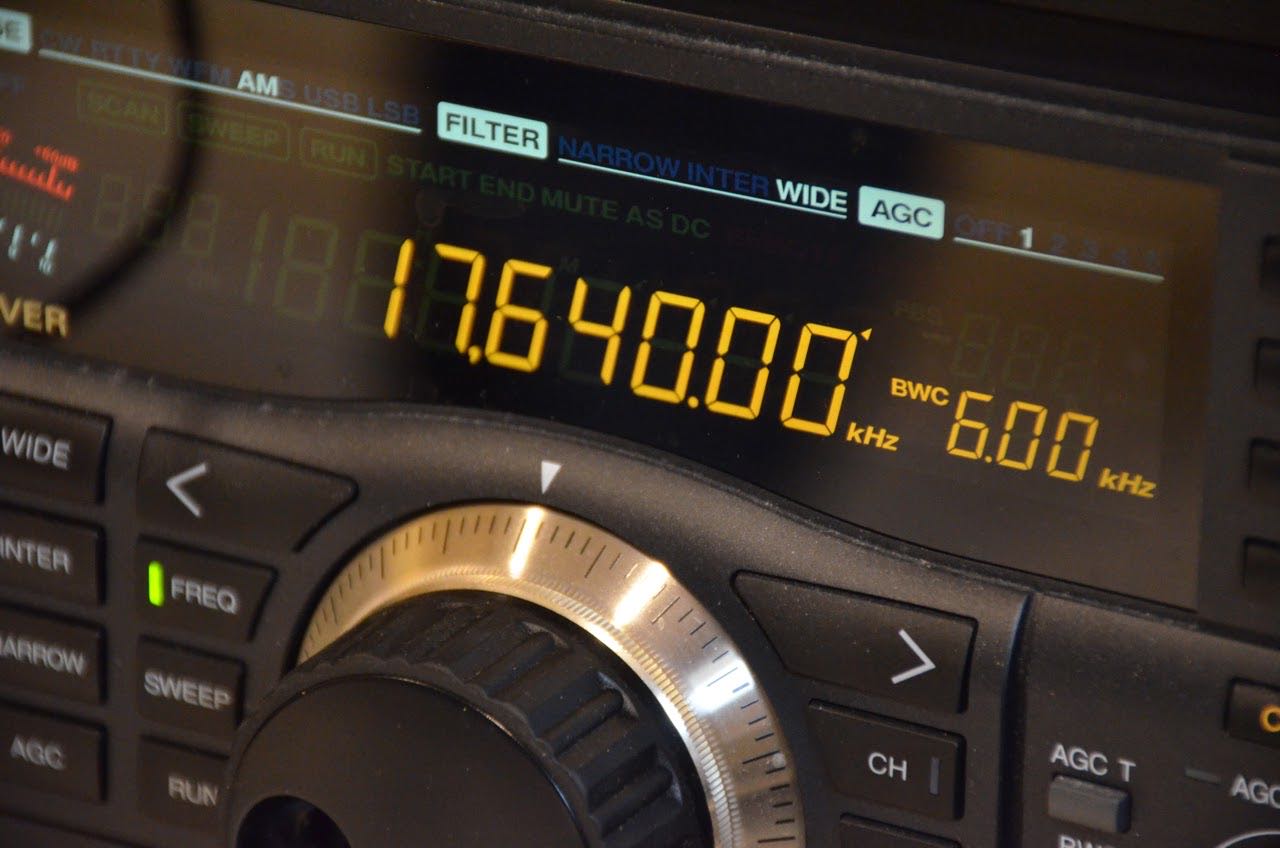 Radio Waves: Stories Making Waves in the World of Radio
Radio Waves: Stories Making Waves in the World of Radio
Because I keep my ear to the waves, as well as receive many tips from others who do the same, I find myself privy to radio-related stories that might interest SWLing Post readers. To that end: Welcome to the SWLing Post’s Radio Waves, a collection of links to interesting stories making waves in the world of radio. Enjoy!
Many thanks to SWLing Post contributors Tony, Dan Robinson, Michael Bird for the following tips:
USAGM CEO Michael Pack thanks interim heads of agency’s five broadcasting networks (USAGM)
WASHINGTON, D.C. — Today, U.S. Agency for Global Media (USAGM) Chief Executive Officer Michael Pack thanked officials who will serve in an interim capacity as the heads of the agency’s two federal organizations and its three public service grantee broadcasting networks.
- Elez Biberaj, who has led Voice of America (VOA)’s Eurasia Division since 2006, will serve as VOA’s Acting Director.
- Jeffrey Scott Shapiro, previously Senior Advisor at Office of Cuba Broadcasting (OCB), will serve as OCB’s Acting Director and Principal Deputy Director.
- Parameswaran Ponnudurai, who has been Vice President of Programming at Radio Free Asia (RFA) since 2014, will serve as RFA’s Acting President.
- Kelley Sullivan, who has been a Vice President at Middle East Broadcasting Networks (MBN) since 2006, will serve as MBN’s Acting President.
- Daisy Sindelar, who has been with RadioFreeEurope/RadioLiberty (RFE/RL) for nearly two decades, will serve as RFE/RL’s Acting President.
CEO Pack sent, in part, the following message to staff:
“The experience of these talented men and women, their knowledge of the networks, and their commitment to the standards of journalism will allow us to launch into the next exciting chapter of our agency. Dr. Biberaj, Mr. Shapiro, Mr. Ponnudurai, Ms. Sullivan, and Ms. Sindelar will serve critical roles in allowing our networks to become higher performing and to more effectively serve our audiences. For their willingness to step up and help lead this effort, I am deeply appreciative. I am excited to serve alongside them as well as with all of you.”
Virginia Air & Space Center Ends Relationship with Ham Radio (ARRL News)
Virginia Air & Space Center (VASC) Executive Director and CEO Robert Griesmer has advised that the Center’s amateur radio station exhibit will be discontinued, effective July 1, when the Center, in Hampton, Virginia, reopens. VASC is the official visitor center for NASA’s Langley, Virginia, facility. The KE4ZXW display station was shut down on March 13. It was to be out of the VASC by June 30. A main feature of the exhibit was the ability to communicate with amateur radio satellites and with the International Space Station.
Randy Grigg, WB4KZI, of the VASC Amateur Radio Group said the station’s equipment would be relocated. “Thanks to all who have supported KE4ZXW during the last 25 years, especially the volunteer operators who manned the station during that time,” Grigg said. “To the many visitors we have met and school groups that have stopped by and talked with us about ham radio, communications, satellites, and STEM Program related subjects, thank you!”
On June 30, it was announced that the Virginia Tech Amateur Radio Association (K4KDJ) in Blacksburg will be the new host for the KE4ZXW Amateur Radio Demonstration. — Thanks to Randy Grigg, WB4KZI, and Ed Gibbs, KW4GF[…]
Why WWV and WWVH Still Matter (Radio World)
Last year was one of both celebration and uncertainty for WWV, the station adjacent to Fort Collins, Colo., that transmits automated time broadcasts on the shortwave bands.
On the plus side, it marked the 100th year of WWV’s call letters, making the site, operated by the National Institute of Standards and Technology, one of the world’s oldest continually operating radio stations.
On the negative side, WWV and its sister time station WWVH in Hawaii nearly missed this centennial. That’s because NIST’s original 2019 budget called for shutting down the pair, along with WWVB, the longwave code station co-located next to WWV, as a cost-saving move.
Fortunately, these cuts never happened, and WWV, WWVH and WWVB seem likely to keep broadcasting the most accurate time from NIST’s atomic clocks, at least for the immediate future. (No further cuts have been threatened.)[…]
Another Shortwave WebSDR operational in Iceland (Southgate ARC)
On June 27, a new KiwiSDR web software defined radio became operational in Iceland
A translation of the IRA post reads:
The new receiver is located in Bláfjöll at an altitude of 690 meters. It has for the first time used, a horizontal dipole for 80 and 40 meters.
The KiwiSDR receiver operates from 10 kHz up to 30 MHz. You can listen to AM, FM, SSB and CW transmissions and select a bandwidth suitable for each formulation. Up to eight users can be logged into the recipient at the same time.
Ari Þórólfur Jóhannesson TF1A was responsible for the installation of the device today, which is owned by Georg Kulp, TF3GZ.
Bláfjöll: http://blafjoll.utvarp.com/The other two receivers that are active are located at Bjargtångar in Vesturbyggð, Iceland’s westernmost plains and the outermost point of Látrabjarg and at Raufarhöfn. Listen at:
Bjargtångar: http://bjarg.utvarp.com/
Raufarhöfn: http://raufarhofn.utvarp.com/The IRA Board thanks Ara and Georg for their valuable contributions. This is an important addition for radio amateurs who are experimenting in these frequency bands, as well as listeners and anyone interested in the spread of radio waves.
Source IRA https://tinyurl.com/IcelandIRA
KiwiSDR Network
http://kiwisdr.com/public/
Do you enjoy the SWLing Post?
Please consider supporting us via Patreon or our Coffee Fund!
Your support makes articles like this one possible. Thank you!

